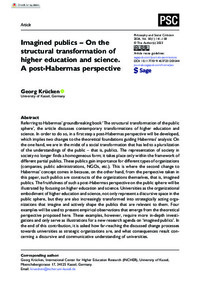| dc.date.accessioned | 2024-03-01T14:30:46Z | |
| dc.date.available | 2024-03-01T14:30:46Z | |
| dc.date.issued | 2023-10-03 | |
| dc.identifier | doi:10.17170/kobra-202403019713 | |
| dc.identifier.uri | http://hdl.handle.net/123456789/15525 | |
| dc.description.sponsorship | Gefördert im Rahmen des Projekts DEAL | |
| dc.language.iso | eng | |
| dc.rights | Namensnennung-Nicht-kommerziell 4.0 International | * |
| dc.rights.uri | http://creativecommons.org/licenses/by-nc/4.0/ | * |
| dc.subject | higher education | eng |
| dc.subject | imagined publics | eng |
| dc.subject | organization | eng |
| dc.subject | social sciences | eng |
| dc.subject | social transformation | eng |
| dc.subject.ddc | 100 | |
| dc.subject.ddc | 300 | |
| dc.title | Imagined publics - On the structural transformation of higher education and science. A post-Habermas perspective | eng |
| dc.type | Aufsatz | |
| dcterms.abstract | Referring to Habermas’ groundbreaking book ‘The structural transformation of the public sphere’, the article discusses contemporary transformations of higher education and science. In order to do so, in a first step a post-Habermas perspective will be developed, which implies two changes to the theoretical foundations guiding Habermas’ analysis: On the one hand, we are in the midst of a social transformation that has led to a pluralization of the understandings of the public – that is, publics. The representation of society in society no longer finds a homogeneous form; it takes place only within the framework of different partial publics. These publics gain importance for different types of organizations (companies, public administrations, NGOs, etc.). This is where the second change to Habermas’ concept comes in because, on the other hand, from the perspective taken in this paper, such publics are constructs of the organizations themselves, that is, imagined publics. The fruitfulness of such a post-Habermas perspective on the public sphere will be illustrated by focusing on higher education and science. Universities as the organizational embodiment of higher education and science, not only represent a discursive space in the public sphere, but they are also increasingly transformed into strategically acting organizations that imagine and actively shape the publics that are relevant to them. Four examples will be used to present empirical observations that emerge from the theoretical perspective proposed here. These examples, however, require more in-depth investigations and only serve as illustrations for a new research agenda on ‘imagined publics’. In the end of this contribution, it is asked how far-reaching the discussed change processes towards universities as strategic organizations are, and what consequences result concerning a discursive and communicative understanding of universities. | eng |
| dcterms.accessRights | open access | |
| dcterms.creator | Krücken, Georg | |
| dc.relation.doi | doi:10.1177/01914537231203544 | |
| dc.subject.swd | Hochschulbildung | ger |
| dc.subject.swd | Habermas, Jürgen | ger |
| dc.subject.swd | Sozialer Wandel | ger |
| dc.type.version | publishedVersion | |
| dcterms.source.identifier | eissn:1461-734X | |
| dcterms.source.issue | Issue 1 | |
| dcterms.source.journal | Philosophy & Social Criticism | eng |
| dcterms.source.pageinfo | 141-158 | |
| dcterms.source.volume | Volume 50 | |
| kup.iskup | false | |


